Sound Class 9 Notes Science Chapter 11
In our daily lives, we encounter various sounds from different sources like people, birds, machines, and more. Sound is a type of energy that allows us to hear through our ears. Similar to mechanical and light energy, sound is also a form of energy. Have you ever wondered if it's possible to produce sound without using any energy? Additionally, what form of energy do we use to generate sound? In this chapter, we will discover how sound is created and how it travels through a medium, such as air or water, to reach our ears.
Production of Sound
Sound is a form of energy that produces a sensation of hearing in our ears.
- Sound is created when objects vibrate or move back and forth.
- Tuning forks and actions like plucking, scratching, rubbing, blowing, or shaking objects can produce sound.
- These activities make objects vibrate, which leads to the production of sound.
- Vibration refers to the quick back-and-forth motion of an object.
- Our voice produces sound through vibrations in the vocal cords.
Propagation of Sound
- Sound can travel through solids, liquids, or gases.
- Sound moves from where it's produced to where it's heard.
- Vibrating objects cause the particles in the surrounding medium to vibrate.
- The vibrating particles push and pull on nearby particles, creating a chain reaction.
- Sound waves are disturbances that propagate through a medium by causing neighbouring particles to oscillate.
- When sound travels, the particles in the medium don't actually move forward but pass on the disturbance.
- Sound waves are mechanical waves that involve the motion of particles in the medium.
Sound Propagation in Air (Longitudinal Wave)
- When a vibrating object moves forward, it pushes and compresses the air in front of it, creating a region of high pressure. This region is called a compression (C), as shown in the following figure. This compression starts to move away from the vibrating object. When the vibrating object moves backwards, it creates a region of low pressure called rarefaction (R).
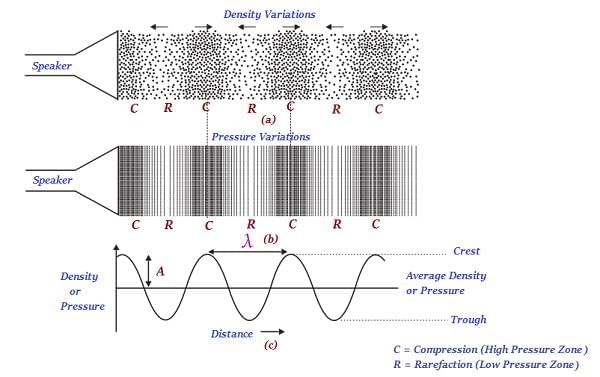 Sound propagates as density or pressure variations as shown in (a) and (b), (c) represents graphically the density and pressure variations.
Sound propagates as density or pressure variations as shown in (a) and (b), (c) represents graphically the density and pressure variations.
- As the object moves back and forth rapidly, a series of compressions and rarefactions is created in the air. These make the sound wave that propagates through the medium. Compression is the region of high pressure, and rarefaction is the region of low pressure.
- In longitudinal waves, particles move parallel to the direction of the wave.
- The particles oscillate around their resting position without changing their location.
- Sound waves are an example of longitudinal waves.
Do you Know? There is another type of wave called a transverse wave.
- In a transverse wave, particles move up and down about their mean position while the wave travels forward. This means that the individual particles of the medium oscillate in a direction perpendicular to the direction of wave propagation.
- A common example of a transverse wave is the ripples formed on the surface of water when a pebble is dropped into a pond.
- Light is also a transverse wave, but it is important to note that the oscillations in light are not of the medium particles, their pressure, or density. This is why light is not considered a mechanical wave.
Characteristics of a Sound Wave
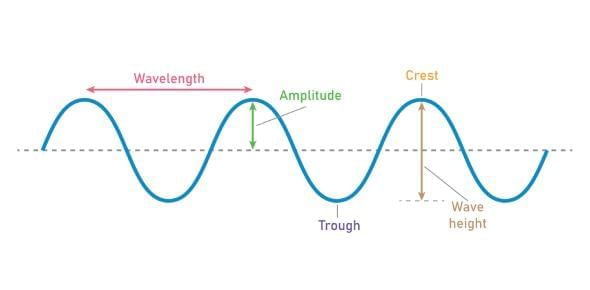
- Wavelength: The distance between two consecutive peaks (crests) or troughs is called the wavelength. Wavelength is represented by λ (lambda) and its SI unit is meter.
- Frequency: The number of oscillations of sound waves per unit time is called its frequency. A number of peaks or troughs per unit of time will give frequency. It is represented by
 (nu) and its SI unit is Hertz (Hz).
(nu) and its SI unit is Hertz (Hz). - Time Period: The time taken to complete one oscillation is called its time period. Its unit is second and is represented by T.
- Relation of frequency and period: Period is the reciprocal of Frequency.

- Amplitude: The magnitude of the maximum disturbance in the medium on either side of the mean value is called the amplitude of the wave. It is usually represented by the letter A. Its unit is a meter.
- Softness or Loudness of Sound: If the amplitude is smaller, then the sound will be softer, and if it is larger, then the sound will be louder. Amplitude affects loudness, not the speed of sound. Speed is determined by the medium.
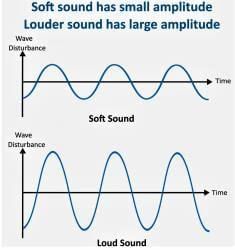
- Pitch: It depends on frequency.
High frequency = high pitch (shrill sound).
Low frequency = low pitch (deep sound).
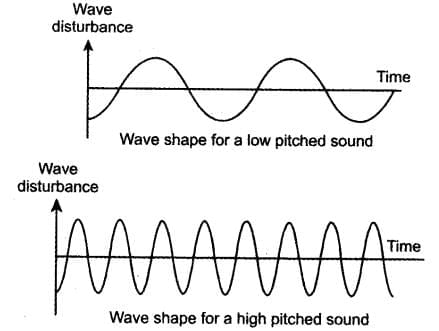
- Speed of sound: It is the distance that a compression or a rarefaction travels per unit of time.
The speed of sound is given by :
 So, Speed = Wavelength × Frequency
So, Speed = Wavelength × Frequency - Intensity: Amount of sound energy passing per second through a unit area. Loudness and intensity are related but not the same.
Speed of Sound In Different Media
- The speed of sound changes across different materials at the same temperature.
- When the temperature rises, the speed of sound in the material also goes up. Thus, the temperature of the medium affects the speed of sound.
- The speed of sound lowers when moving from solids to gases, depending on the medium's characteristics.
- The speed of sound is mainly influenced by the medium and its temperature, not constant across all frequencies.
- Tables show the speeds of sound at specific temperatures in different materials.Speed of Sound in Different Media at 25º C
Reflection of Sound
Sound reflects off a surface in the same way as light reflects and follows the same rules of reflection. The angle of incidence is equal to the angle of reflection, and all three—the incident ray, reflected ray, and normal—lie in the same plane.
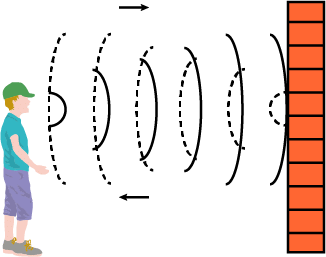 Reflection of Sound
Reflection of Sound
Echo
- If we shout or clap near a suitable reflecting object like a tall building or a mountain, we hear the same sound again after a short time.
- This repeated sound is known as an echo.
- The sensation of sound stays in our brain for about 0.1 seconds. Therefore, to hear a clear echo, there must be a time gap of at least 0.1 seconds between the original sound and the reflection.
- Assuming the speed of sound in air is 344 m/s at a temperature of 22 °C:
The sound must travel to the reflecting surface and back to the listener's ear in 0.1 seconds.
This means the total distance covered by the sound must be at least (344 m/s) × 0.1 s = 34.4 m. - Thus, for a distinct echo, the reflecting object must be at least 17.2 m away from the sound source.
- This distance can change with the temperature of the air.
- We can hear echoes multiple times due to successive or multiple reflections.
Reverberation
- A sound made in a large hall continues to be heard due to repeated bouncing off the walls until it fades away and cannot be heard anymore.
- This continuation of sound in a space like an auditorium occurs because of many reflections and is known as reverberation.
- In a large hall or auditorium, too much reverberation is not wanted. To lessen reverberation, the ceilings and walls are often covered with materials that absorb sound, such as Compressed fibreboard, rough plaster and Draperies.
- The materials used for seating are also chosen based on how well they absorb sound.
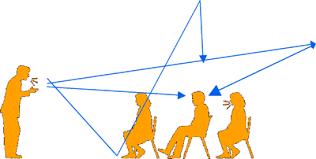 Reverberation of Sound
Reverberation of Sound
Uses of Multiple Reflections of Sound
- Megaphones, loudhailers, horns, and musical instruments like trumpets and shehanais are designed to direct sound in a specific direction instead of spreading it in all directions. These instruments have a tube and a conical opening that reflect sound waves one after another, guiding most of the sound towards the audience.
- A stethoscope is a medical tool used by doctors to listen to sounds produced inside the body, particularly in the heart or lungs. The sound of the patient's heartbeat reaches the doctor's ears through multiple reflections of sound within the stethoscope.
- In concert halls, conference halls, and cinema halls, the ceilings are often curved to ensure that sound reaches all corners of the hall. This helps to distribute sound evenly throughout the space. Sometimes, a curved soundboard is placed behind the stage to reflect sound and ensure it spreads across the entire width of the hall.
Range of Hearing
1. Audible Sounds: Sounds which can be heard by us.
2. Range of Hearing in humans: From 20 Hz to 20000 Hz.
3. Inaudible Sounds: Sounds that we are not able to hear.
4. Humans can not hear: Sounds above 20000 Hz are called ultrasonic, and sounds below 20 Hz are called infrasonic.
Applications of Ultrasound
1. Cleaning Hard-to-Reach Objects
- Ultrasound cleans parts in difficult-to-reach areas.
- Objects are placed in a cleaning solution, and ultrasonic waves remove dust, grease, and dirt.
- Effective for complex shapes like spiral tubes and electronic components.
2. Detecting Cracks and Flaws
- Ultrasound detects cracks and flaws in metal blocks used in construction.
- Waves pass through the block, and detectors identify transmitted and reflected waves.
- Reflected waves indicate the presence of weaknesses that can affect the structure.
3. Medical Imaging: Echocardiography
- Ultrasound reflects waves from different parts of the heart, creating an image.
- Helps diagnose heart conditions and abnormalities.
4. Medical Imaging: Ultrasonography
- Ultrasonic waves create images of internal organs.
- Changes in tissue density cause waves to reflect, which are converted into electrical signals.
- Aids in detecting abnormalities like stones or tumours.
- Useful for examining the foetus during pregnancy to identify defects and growth issues.
5. Medical Treatment: Kidney Stone Breakage
- Ultrasound breaks small kidney stones into fine grains.
- Allows stones to be flushed out naturally, avoiding invasive procedures.
|
85 videos|549 docs|60 tests
|
FAQs on Sound Class 9 Notes Science Chapter 11
| 1. What is the process of sound production? |  |
| 2. How do sound waves propagate through different media? |  |
| 3. What are the main characteristics of a sound wave? |  |
| 4. How does the reflection of sound work? |  |
| 5. What are some applications of ultrasound in various fields? |  |


















